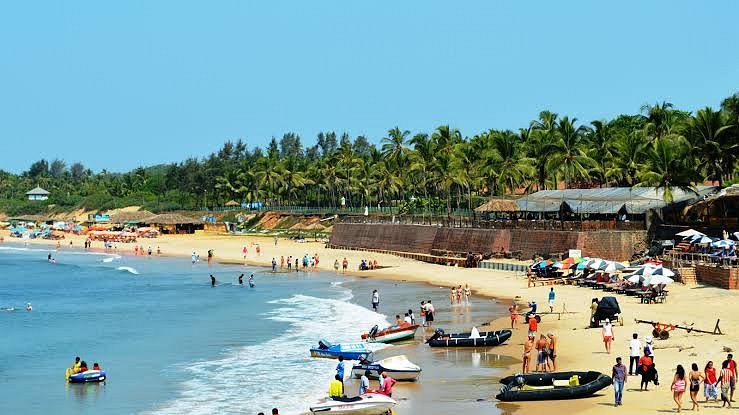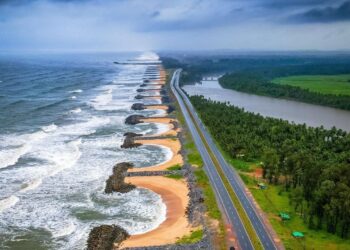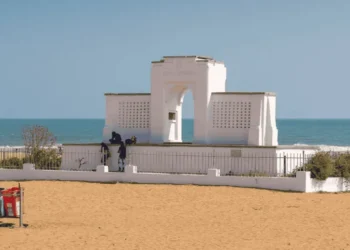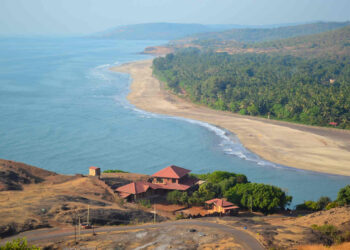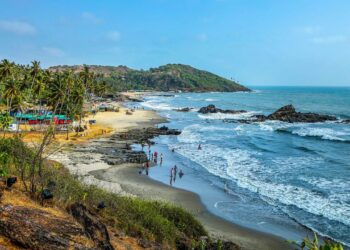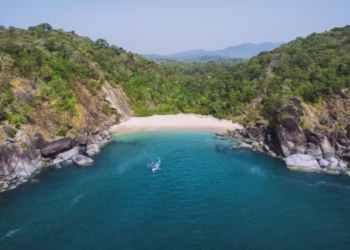Morjim Beach is a calm and wide stretch of sand beach facing the blue Arabian Sea resting in the North Goa’s Pernem area. The beach runs for nearly three kilometers, covered with soft white sand and touched by slow, rolling waves. It lies close to the mouth of the Chapora River, which gives the place a peaceful mix of river and sea together. From Panaji, the capital of Goa, it is about 28 kilometers away, making it easy to reach but still far from the heavy crowds.
Fun Fact About Morjim Beach
A quite unique thing about Morjim Beach is its role as a key nesting site for the endangered Olive Ridley turtles. Every year from October to March, hundreds of these turtles come ashore to lay eggs, and hatchlings scramble to the sea at night.
There is also a small Turtle Information Centre near the beach where visitors can learn about their life cycle and the protection work done by forest officials. Sometimes, people can take part in guided walks to see the nesting from a safe distance.
Because of this, Morjim is known as one of Goa’s few protected turtle beaches, where quiet nights often turn into peaceful and beautiful moments of nature.
History of Morjim Beach
The story of Morjim Beach began long ago, when it was just a quiet fishing spot for the local Konkani people living by the Arabian Sea. The name “Morjim” is said to come from the word mhor, meaning peacock in the local tongue. Some old stories say that Goddess Sita once came to this land riding a peacock, while others believe the area rose from the sea through the blessings of a saint. To honor him, villagers built the Morjai Temple, which still stands not far from the shore.
During the Portuguese period, starting from the early 1500s, Morjim stayed calm and less noticed. It stood close to Chapora Fort, built around 1617 to guard the coastline. Fishermen from the nearby villages used the river mouth for their small boats, trading fish, salt, and rice along the Goan coast.
Things slowly started to shift around the 1960s when travelers from Europe and other places began coming to Goa. Morjim’s calm air and wide beach drew people who liked a simple life near the sea. Many of them stayed on for weeks or even months, spending time making music, meeting locals, and living together in small groups close to the shore.
In the 1990s, Russian tourists began arriving in large numbers, and slowly, the place earned the name “Little Russia.” A few small shacks and cafes were opened by locals and foreign visitors together, giving the beach a relaxed international feel.
Around 1997, turtle conservation work began, as Olive Ridley turtles were often seen nesting there. In the early days, only a few nests were protected, but now many more are watched over each year. After India’s independence, roads improved and tourism grew, yet Morjim managed to hold on to its calm, natural look.
Things to Do at Morjim Beach
Morjim Beach is actually quite a calm and serene place where one can spend some time close to the nature and enjoy small but peaceful moments.
See the Sunrise and Sunset: Early morning brings soft light and quiet waves, nice for walking or stretching by the sea. By evening, the sky turns golden as the sun goes down near the river, and people come to sit on the sand with friends or family.
Turtle Watching: Between October and March, you can take a guided visit to see Olive Ridley turtles lay eggs or the small ones moving toward the sea. There’s also a small centre that tells about their life cycle. Entry is free, but you need to book before visiting.
Water Fun: The sea here is calm enough for kayaking or a slow boat ride on the Chapora River where dolphins are sometimes seen. A ride costs about ₹500–₹1,000. Jet ski or parasail rides also happen (₹600–₹1,500), but visitors are asked not to disturb turtle areas.
Beach Games: The open sand is nice for volleyball, flying kites, or just building small forts with driftwood. Horse rides along the shore are common, especially when the sun goes down, costing around ₹100–₹300.
Try Local Food: Beach huts and small cafes serve prawn curry, crab fry, or a simple fish thali. Some places also serve Russian food like borscht or pancakes. You can buy cashews or local feni from nearby stalls.
Places Around: The famous Chapora Fort is about 5 km away and gives a good sea view. It was shown in the film Dil Chahta Hai. You can also walk a bit inland to Morjai Temple, which has old carvings and stories tied to local legends.
Walks and Nature: A quiet walk through the palm trees often shows colorful birds like kingfishers and eagles. If you go a little further north, Ashwem Beach joins Morjim and makes a nice long walk for peaceful evenings.
Best Time to Visit Morjim Beach
October to March:
This is the nicest season to come, when the weather stays pleasant around 22°C to 32°C. The sea is calm, and it’s the time when Olive Ridley turtles come to nest. Water rides and outdoor walks are easy to enjoy. December is busy with tourists, so beach huts and hotels should be booked earlier.
April to June:
These months are warmer, around 28°C to 36°C. It’s better to visit early morning or late afternoon when it’s cooler. The crowd becomes less, which gives a quiet time, though the air gets more humid.
July to September:
Rainy months bring a fresh, green look to Morjim. Temperatures stay near 25°C to 30°C. Boat rides and sea sports often stop due to waves, but prices for rooms go down, and the calm mood of the place feels peaceful.
